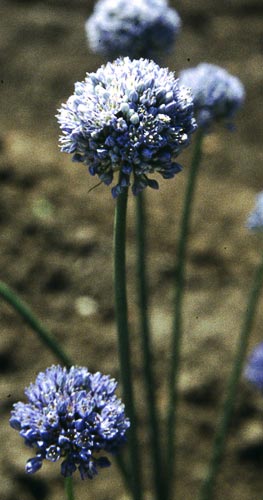Relatives
Allium caesium Schrenk - Blue onion.
Taxonomic position.
Family Alliaceae J.Agardh, genus Allium L.Synonyms.
Allium urceolatum RegelMorphology and biology.
Perennial. Geophyte. Bulbous. Bulb ovoid, 1-1.5 cm diameter, with grey scarious tunics. Substituting bulbils greyish-brownish or more often violet with obscure longitudinal veins. Scape 15-65 cm tall, up to 1/4-1/2 of its height covered with scabrous (less often smooth) leaf sheaths. Leaves 2-3, semicylindrical, channelled, hollow, 1-3 mm wide, slightly longer or shorter than scape. Spathe persistent, acuminate, 2 shorter than umbel. Umbel semispherical or spherical, many-flowered, dense. Between some flowers of the inflorescence there are small bulbils, specimens occur with inflorescences consisting of only bulbils or only flowers. Pedicels equal to each other, 2-3-(5) times as long as perianth, with bracts at the base. Tepals of campanulate perianth 4-6 mm long, blue with dark vein, oblong or oblong-lanceolate, obtuse or more often acutate. Filaments 1/4 shorter than tepals, at the base fused with each other and with perianth, outer ones subulate with triangular base, inner ones obtusely dentate, 2 times wider. Style slightly exserted from perianth. Autochore. Flowers in May - June, fruits in June - July.Distribution.
Middle [Central] Asia (Kazakhstan, Dzungarian Alatau, Tien Shan, Pamiro-Alai).Ecology.
Photophilous. In steppe and semi-desert zones, on solonetz (sodium-rich) soils, in foothills and middle montane zone.Use and economic value.
Wild relative of cultivated onions.References:
Vvedensky AI. 1935. Onion . Allium L. In: Komarov VL., ed. Flora URSS. V.4. Moscow; Leningrad: AN SSSR. P.222-223. (In Russian).Schreder RR., ed. 1941. Flora of Uzbekistan. V.1. Tashkent. P.446-447. (In Russian).


